Colheita de águas pluviais para armazenamento e recuperação de aquíferos em Adelaide
Austrália do Sul
stormwater
Voltar
Download the practice
People in charge of the innovative practice :
Não conhecido


Responsible entity
The Salisbury Water MAR Scheme is operated by the Salisbury Water team, a separate business unit of the City of Salisbury (Fig. 2). The unit acts as a water service provider that supports Council’s initiatives to deliver economic, environmental and social benefits to the community.
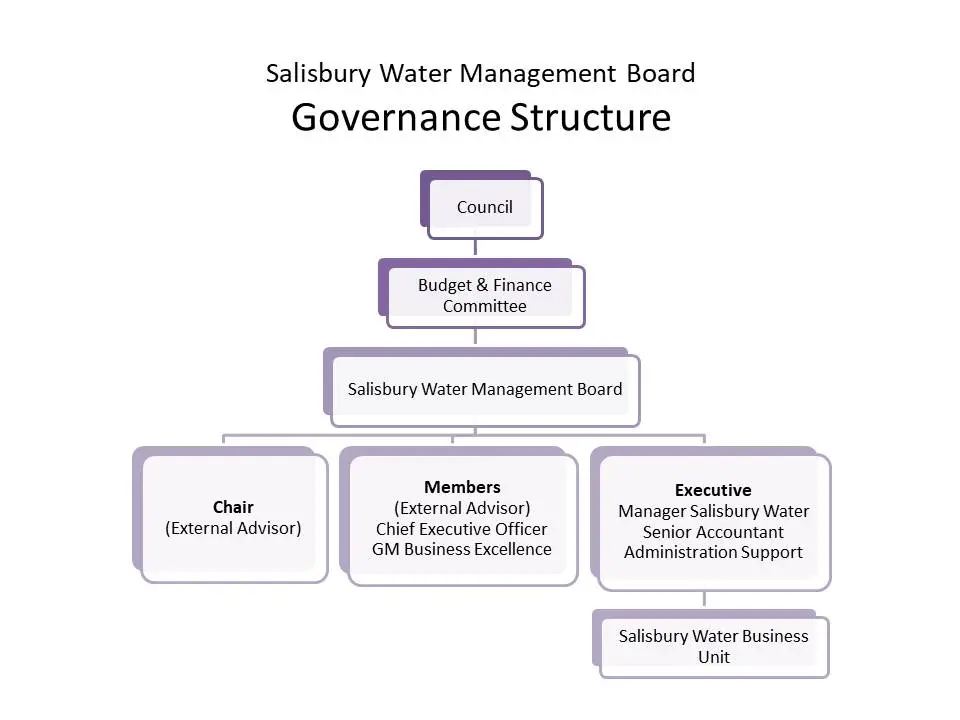
Fig. 2 – Salisbury Water governance structure
Other key partners took an important role in the initial stage of the Salisbury MAR scheme feasibility and implementation, both from the public and private sectors (Tab. 1) (Zheng et al., 2021).

Detailed explanation
Salisbury Water MAR Scheme relies on two different methods: Aquifer storage and recovery (ASR) and Aquifer storage, transfer and recovery (ASTR) The latter involves injecting water into a well for storage, and recovery from a different well, while in ASR water is recovered from the same well (Page et al., 2018) – Fig. 6. A major attraction of the use of injection wells (bores) and aquifer storage in an urban context is that only a small surface footprint is required for the wellhead works to achieve large storage which can underlie the urban development it serves (Kellogg Brown & Root Pty Ltd, 2004).
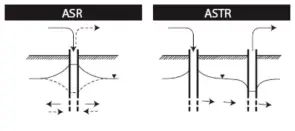
In the Salisbury approach, Wetland treated urban stormwater is stored via aquifer storage and recovery (ASR) and aquifer storage transfer and recovery (ASTR) in confined limestone aquifers to provide a sustainable water supply that is distributed to customers via a dedicated non-potable ‘purple pipe’ network
On a general basis the general working practice is the following: During the high rainfall period in winter, excess stormwater, filtered and cleansed by the wetlands, is pumped into the aquifer which is up to 220 m below the ground. During the summer, the water is recovered as needed.
Monitoring at one of the early constructed wetlands in the early 1990s demonstrated that water quality significantly improved. Driven by the need to cut costs in irrigation of adjacent sports fields, Salisbury Council started the investigation for use of the wetland water (Zheng et al., 2021). The first ASR trial in 1994, used the Lower Tertiary sandy limestone aquifer (Paddocks ASR scheme, capacity 0.05×106 m3). Recovered water diverted to an ornamental lake and subsequently used in irrigation. A wool company started to use water from this installation at Salisbury South for scouring trials as the low salinity recovered water required less detergent in the wool scouring process. The trial resulted in a partnership between Salisbury Council, Michell Wool and Parafield Airport Ltd., with funding support from the Australian Government to build a stormwater recycling facility on the runways of Parafield Airport, commonly referred to as the ‘Water Factory’. This initiative has supplied 1-3 x103 m3/day for the Michell Wool operations. The Paddocks and Parafield schemes (capacity 1.1×106 m3) are now important hubs that supply recycled water to over 1 000 customers and 5 000 homes via 3rd party retailers.
The Parafield system is a constructed wetland and consists of three basins: an in-stream basin, a holding storage basin and a cleansing reed bed basin (Fig. 7). The in-stream basin catches the stormwater runoff from the catchment area, slowing flow, removing suspended solids and diverting it to the holding storage basin. The water in the storage basin flows into the reed bed basin by natural gravity. The water that passes through the reed bed is then seasonally (mainly in winter) injected and stored in adjacent aquifers. The treated water is stored in aquifer storage and recovery system (ASR). The reed bed basin is covered by bird netting, which prevents birds from entering and contaminating the system. Water flowing in the reed bed is regulated to ensure a retention time of ten days and a water level of 30-70 cm (Page et al., 2010).
The total land area of this system is 11.2 ha and the catchment area is 1600 ha, mainly residential area with a small number of parkland areas and an industrial area. The catchment area is serviced with a complex stormwater drainage system for the collection of stormwater runoffs, which is mainly street and roof drainage.
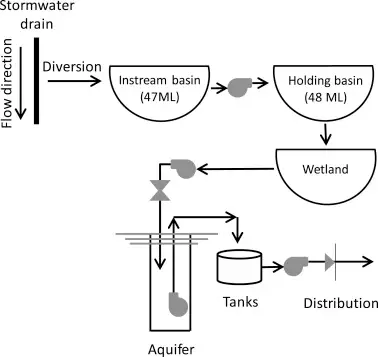
The project capital cost was AUS$4.5 million, with the initial funding support of AUS$1.4 million through the Commonwealth’s Environment Australia Urban Stormwater Initiative, AUS$1million from GH Michell & Sons Australia (wool company), AUS$140 000 from the Northern Adelaide Plains Barossa Catchment Water Management Board, an in-kind contribution of AUS$40 000 from the then SA Department of Water Resources, with the balance being funded by the City of Salisbury (Radcliffe et al., 2017).
Salisbury has today over 150 km of recycled water pipes and the whole system is composed of 31 ASR wells and 32 ASTR wells (Fig. 8).
REPLICATION POTENTIAL IN SUDOE REGION
The Salisbury Water example is already being adopted nationally and abroad, such as Western Australia Perth’s GWRS strategy to improve long-term water security for the city using water banking via ASTR (Vanderzalm et al., 2020).
The main issues of ASR relate to source water quality and the technical feasibility at the selected location (hydrogeological and technical system design to achieve benefits that exceed costs, system compliance with existing regulations and establishment of consultative mechanisms to allow stakeholder negotiations). In urban setting issues usually revolve around constraints on available storage or, if the water is of low quality, the need for additional infrastructure to deliver enough water to comply with demand (Martin & Dillon, 2002).
The Mediterranean region is expected to face similar problems with extreme events related to climate change and MAR/ASR may provide a suitable solution in urban and peri-urban areas. Although not directly related to MAR and ASR, Portuguese Lisbon municipality, in collaboration with local water services company, is currently establishing the construction of a system of ducts in the city, which will make it possible to create a network of recycled and safe water for reuse in irrigation and washing from the Water Factories (prior WWTP). The overall reduction in drinking water consumption has been one of the municipality’s major strategic objectives, and the reused water network is a decisive step in this direction, having been one of the measures most valued by the European Commission for awarding Lisbon the distinction of European Green Capital 2020.
Future outlook
Stormwater abundance may be a problem in the near future. In Australia, impacts of climate change are emerging with the nationally-averaged rainfall was 40% below average for the year at 277.6 mm, when it was 465.2 mm for 1961–1990 (Radcliffe and Page, 2020). On the other hand, from the economics perspective, nature-based technologies may have a wider role in the future with smaller investments required in the long term. The Salisbury Water wetland-ASR provided an additional drinking water supply with notable savings and low complexity systems if compared with WWTP tertiary treatment schemes (Radcliffe and Page, 2020).
Institutional setting
The first issue to be addressed is the protection of groundwater quality and the standards of the quality of water to be injected. Australia was one of the first nations to develop and guidelines for risk-based management of Managed Aquifer Recharge – Australian Guidelines for Water Recycling: Managed Aquifer Recharge (“MAR Guidelines”) (NRMMC-EPHC-NHMRC, 2009). These were developed under the experience gathered through decades of research and investigations.
The guidelines were the outcome of a two-year Urban Water Research Association of Australia study that reviewed international practice and guidelines for artificial recharge of waters by injection. South Australia’s, Andrews Farm experimental ASR site was used as a case study to demonstrate the viability and sustainability of injecting urban stormwater that received only passive treatment in flood detention ponds, into a brackish aquifer, recovering for irrigation (Martin & Dillon, 2002).
These guidelines enforce high performance concerning environmental sustainability and cover licensing, pre-treatment, monitoring, guidance for maximum contaminant concentrations in injectant, residence time prior to recovery and management of ASR operations and provide a clear path for implementation (Fig. 3).
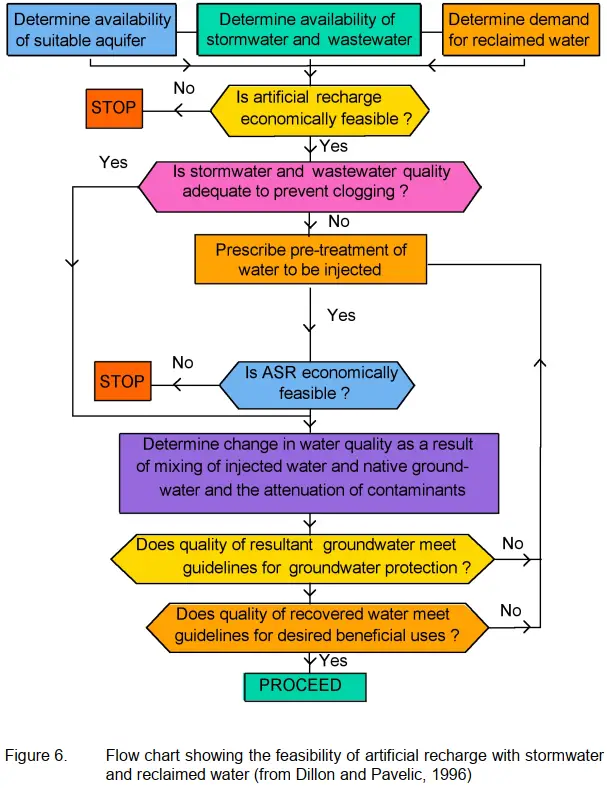
Geographical setting
Southern and Western Australia are two of the most water-challenged parts in Australia (Prommer et al., 2013), experiencing a drying climate over the last 40 years, with severe droughts during the last decade combined with rapid population growth and urban development. In Australia’s biggest cities, climate projections for the next several decades show predominantly increased aridity, particularly in the southern winter wet-season, and increased evapotranspiration The projected increased intensity of extreme daily rainfall events has implications for stormwater runoff. High rainfall intensity can lead to flooding and less recharge to groundwater in some environments where the infiltration capacity of the soils is exceeded. Coastal areas that rely on groundwater sources can also face saltwater intrusion. To cope with this Australia has invested heavily in the implementation of sustainable urban water management procedures which include managed aquifer recharge (MAR) (Fig. 4).
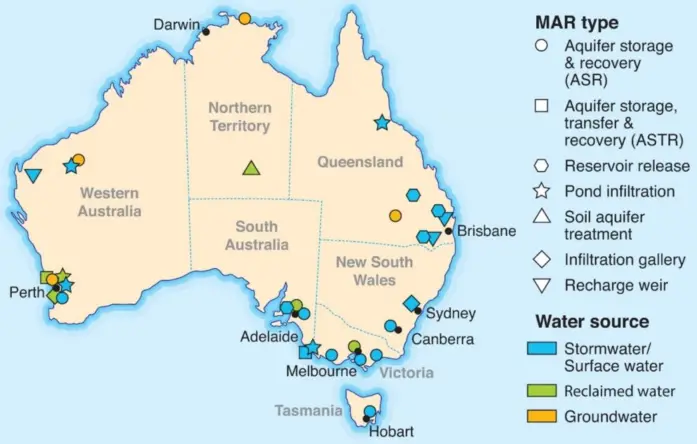
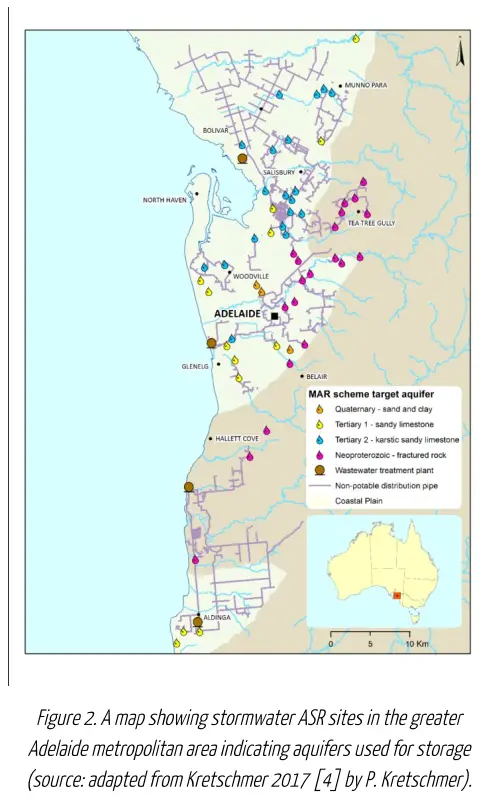
Historical overview
The use of stormwater as a supplementary water resource in Adelaide was first considered in the early 1950s to enhance brackish aquifers and provide a reserve for times of water shortage. The concept has been deemed more important with the realisation that the Murray River, a major source of Adelaide’s water supply, was significantly compromised in quantity and quality through overuse by irrigators and associated saline drainage impacts (Kellogg Brown & Root Pty Ltd, 2004).

The millennial drought – a period of reduced rainfall at the beginning of the XXI century – forced the Australian water industry to adapt. The National Water Initiative (NWI) was passed and laid the basis for water markets, trading and pricing but also lead to the development of regulatory guidelines on the use of stormwater and recycled water (Vanderzalm et al., 2020).
Only in 1994, Salisbury’s first ASR trial commenced and in 1999 Parafield Stormwater Harvesting Facility was assembled to supply a wool processing company (Kim, 2010). Other hubs connected by reticulation network from 2001, with significant upgrades completed between 2012 – 2016, while the official regulated sale of water supply commenced in 2004.
Evidence of benefits from implementation
Salisbury Water reported multiple benefits to both the local community and the wider region. The most relevant are:
- Reduced demand on existing water resources such as the Murray River and the Adelaide Hills Water Catchments
- Increased local biodiversity through the establishment of over 50 wetlands which provide a habitat for bird species.
- Reducing the volume of stormwater run-off and helping to protect the sensitive marine environment of the Barker Inlet in St. Vincent Gulf.
- Increased opportunities for environmental education and research and public awareness with community volunteer engagement.
- Salisbury Water to irrigate is helping to keep the city’s green infrastructure which also provided recreational activities.
- Increased water availability allows for irrigation even during drought periods.
- Increased flood protection for property
- Natural treatment of stormwater enabled a low-cost treatment option for community use and an alternative water supply for industry (savings of over AUS$3 million each year) (Zheng et al., 2021).
The social acceptance of stormwater use was assessed using surveys “Would you support case A, B or C for stormwater use?” and “Would you trust authorities to ensure the quality of water of these cases?“. following three options: The results showed that the support for stormwater schemes is high for all three options (Fig. 9) (Dandy et al., 2019)
(A) Treatment through a wetland and aquifer storage and recovery and then delivery to their house via a separate third pipe network where it could be used for garden watering, toilet flushing and in the washing machine.
(B) Treatment through a wetland, aquifer storage and recovery and delivery to a water supply reservoir for blending with other source water before being further treated through a water treatment plant. The water would then be distributed through the water supply mains for drinking and other purposes.
(C) Treatment through a wetland and aquifer storage and recovery and then direct injection into the water supply mains for drinking and other purposes.

Key points of the innovative method
- Non-drinking water in the City of Salisbury is referred to as Salisbury Water and is a mix of treated stormwater and native groundwater which is used to irrigate parks, reserves, schools and industry.
- Collection, storage and distribution uses constructed wetlands, managed aquifer recharge (MAR) and ‘purple pipe’ distribution network across the city
- Use alternative water for non-drinking water purposes allows to reduce treatment costs and allow throughout the year.
- Wetlands also provide flood protection and increase local biodiversity with recreational opportunities
- Capture, treat and reuse stormwater to help protect the sensitive downstream marine environments
Acknowledgements
This innovative practice was suggested by Sergi Compte from Catalan Water Partnership.
References
Dandy, G.C., Marchi, A., Maier, H.R., Kandulu, J., MacDonald, D.H., Ganji, A., 2019. An integrated framework for selecting and evaluating the performance of stormwater harvesting options to supplement existing water supply systems. Environmental Modelling & Software 122, 104554. https://doi.org/10.1016/j.envsoft.2019.104554
Dillon, PJ & Pavelic, P, 1996. Guidelines on the quality of stormwater and treated wastewater for injection into aquifers for storage and reuse. Research Report No 109, Urban Water Research Association of Australia.
Kellogg Brown & Root Pty Ltd, 2004. Local Government Association and State Government of South Australia. Metropolitan Adelaide Stormwater Management Study. Part B – Stormwater Harvesting and Use. Prepared for the Metropolitan Adelaide Stormwater Management Steering Committee.
Kim, Y.-K., 2010. Nutrient sources and dynamics in the Parafield stormwater harvesting facility and implication to water quality control. (Thesis). https://digital.library.adelaide.edu.au/dspace/bitstream/2440/57033/8/02main.pdf
Kretschmer, P, 2017, Managed Aquifer Recharge Schemes in the Adelaide Metropolitan Area, DEWNR Technical report 2017/22, Government of South Australia, Department of Environment, Water and Natural Resources, Adelaide. https://www.waterconnect.sa.gov.au/Content/Publications/DEW/Managed%20Aquifer%20Recharge%20Schemes%20in%20Adelaide_Final.pdf
Martin, R., Dillon, P., 2002. Aquifer storage and recovery in South Australia. Water. 29. 28-30. https://www.researchgate.net/publication/288303894_Aquifer_storage_and_recovery_in_South_Australia
NRMMC-EPHC-NHMRC, 2009. Australian Guidelines for Water Recycling: Managed Aquifer Recharge. National Water Quality Management Strategy Document No. 24. Australia.
Page, D., Dillon, P., Vanderzalm, J., Bekele, E., Barry, K., Miotlinski, K., Levett, K., 2010. Managed Aquifer Recharge case study risk assessment. CSIRO. Water for a Healthy Country. National Research Flagship.
Page, D.W., Peeters, L., Vanderzalm, J., Barry, K., Gonzalez, D., 2017. Effect of aquifer storage and recovery (ASR) on recovered stormwater quality variability. Water Research 117, 1–8. https://doi.org/10.1016/j.watres.2017.03.049
Page, D., Bekele, E., Vanderzalm, J., Sidhu, J., 2018. Managed Aquifer Recharge (MAR) in Sustainable Urban Water Management. Water 10, 239. https://doi.org/10.3390/w10030239
Prommer H, Descourvieres CD, Handyside M, Johnston K, Harris B, Li Q, Fang H, Costello P, Seibert S, Martin M, 2013. Final Report – Aquifer storage and recovery of potable water in the Leederville Aquifer. CSIRO: Water for a Healthy Country National Research Flagship, Australia.
Radcliffe, J.C., Page, D., Naumann, B., Dillon, P., 2017. Fifty years of water sensitive urban design, Salisbury, South Australia. Front. Environ. Sci. Eng. 11, 7. https://doi.org/10.1007/s11783-017-0937-3
Radcliffe, J.C., Page, D., 2020. Water reuse and recycling in Australia — history, current situation and future perspectives. Water Cycle 1, 19–40. https://doi.org/10.1016/j.watcyc.2020.05.005
Vanderzalm, J., Naumann, B., Higginson, S., Page, D., Jones, A., Moscovis, V., Hamilton, S., Gonzalez, D., Dandy, G., Barry, K., Dillon, P., Prommer, H., Donn, M. (2020) Australian exemplars of sustainable and economic managed aquifer recharge. Water e-Journal Vol 5 No 4 https://www.awa.asn.au/resources/latest-news/environment/natural-environment/australian-exemplars-of-sustainable-and-economic-managed-aquifer-recharge
Zheng, Y., Ross, A., Villholth, K.G. and Dillon, P. (eds.), 2021. Managing Aquifer Recharge: A Showcase for Resilience and Sustainability. Paris, UNESCO. https://unesdoc.unesco.org/ark:/48223/pf0000379962.locale=en
Salisbury Water Information Brochure 2021/22 (https://www.salisbury.sa.gov.au/assets/files/content/public/services/salisbury_water/Salisbury_Water_Information_Brochure_-_2021-2022.pdf)
Salisbury Alternative Scheme – Water Sensitive Cities (https://watersensitivecities.org.au/wp-content/uploads/2018/10/26-Salisbury-Water-Alternative-Water-Scheme_FINAL.pdf)
Participating members:
Salisbury Water (https://www.salisbury.sa.gov.au/services/salisbury-water/what-is-salisbury-water)
aquifer
NOTÍCIAS
Descubra mais sobre as notícias do projeto AQUIFER e sobre a gestão de aquíferos
NOTÍCIAS AQUIFER
Descrição e objectivos do projecto
The scientific community recommends a substantial improvement in the knowledge of aquifers, the establishment of reliable monitoring networks and a greater involvement of the administration and users to achieve a sustainable management of aquifers. The main objective...
Informação sobre o projecto
A Comunidade de Utilizadores de Água do Delta Llobregat concebeu bacias de recarga em Molins de Rei para recarregar o aquífero do Baix Llobregat. Vista de uma das bacias de recarga durante a fase de teste A Comunidade de Utilizadores de Água de Llobregat Delta é um...
Histórias de sucesso na gestão das águas subterrâneas
Compilação de histórias de sucesso na gestão das águas subterrâneas. Ao longo do mês de Abril, os 30 casos de práticas inovadoras na gestão das águas subterrâneas já foram seleccionados pelos agrupamentos que participam no projecto: PPA, CWP e AV. A tarefa começou com...
PROPONHA UMA
PRÁTICA INOVADORA
Está a desenvolver ou implementar uma prática inovadora em matéria de gestão de aquíferos e deseja referência-la na plataforma do projeto AQUIFER?
Preencha o formulário e faça uma proposta aos parceiros do projeto AQUIFER.
THE E-BOOK
O Aquífero oferece uma gama de práticas inovadoras de gestão da água. Pode descarregar todas as nossas fichas técnicas aqui.
E-BOOK DE PRÁTICAS INOVADORAS
DOCUMENTAÇÃO
Aprofunde a informação relacionada com a gestão dos aquíferos